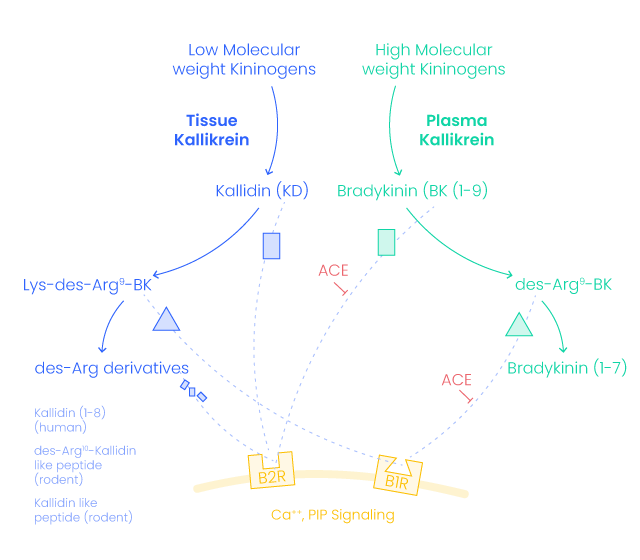Bradykinin Peptides
Bradykinin & COVID-19
- Bradykinin may be dysregulated in COVID-19 patients
- Recent studies point to potential bradykinin-ACE2 interplay in COVID-19 pathophysiology owing to increased bradykinin release; impaired bradykinin regulation and upregulation of ACE2 and bradykinin receptors (1).
Figure : Bradykinin potentiation by ACE influence signifying crosstalk between the RAAS and the Kinin-kallikrein systems
How are the kinin peptides formed?
Kinin peptides are formed via the Kinin-Kallikrein system following cleavage of a kininogen precursor and interaction of various molecular factors like factor XII, pre-kallikrein, kininogen etc on surfaces of cells (2). The signaling of bradykinin receptors is mediated by kinins, which are produced following cleavage of kininogens by Kallikreins, serine proteases. This comprises the kallikrein–kinin system (KKS) (3, 4). The two main 'kinins' in mammals are the nonapeptide bradykinin, BK (1-9) and the decapeptide kallidin (KD), [Lys0]-BK(1-10). The class also includes methionyl-lysyl-BK, and their C-terminal des-Arg derivatives (4). Their biological actions are mediated by two distinct receptors, termed B1 and B2. (3). (Figure). Kinins can bind either receptor, but they demonstrate receptor selectivity. BK and KD bind preferentially to B2R, while des-Arg9-BK and Lys-des-Arg9-BK bind preferentially to B1R (5). Kinins are also enzymatically regulated by kininase II (ACE), neprilysin, and endothelin-converting enzyme (3).
Figure : Formation and breakdown of kinins as part of kinin-kallikrein signaling
Role of the kinin peptides and receptors in disease:
Bradykinins (BKs) belong to a family of short, structurally similar peptides that are important metabolites of the kallikrein-kinin system.
Bradykinin lowers blood pressure
BKs are vasoactive nonapeptides formed by the action of proteases on the high-molecular-weight kininogen during the contact phase of blood coagulation, resulting in endothelium-dependent vasodilatation and stimulation of tissue plasminogen activator release from human endothelial cells. Vasodilation results in lowering blood pressure. ACE inhibitors, which are used to lower blood pressure increase bradykinin expression. mechanisms by which bradykinins lower blood pressure include the release of nitric oxide, prostacyclin (prostaglandin l2) and endothelium-derived hyperpolarizing factor.
Bradykinin also contracts smooth muscles and is a potent stimulator of nitric oxide formation by vascular endothelium. It also stimulates prostacyclin formation. Bradykinin is involved in edema resulting from trauma or injury and aid in dissolving blood clots. When it is secreted by eccrine sweat glands, it causes the surface of blood vessels to dilate and help radiate excessive heat from the body surface, making it an important peripheral thermoregulatory molecule.
Bradykinin production in the lung increases with many pulmonary diseases such as asthma, bronchitis, and pneumonia.
B1 and B2 receptors - therapeutic targets in cardiovascular disease
It is important to note that both B1 and B2 receptors are considered as therapeutic targets as they are implicated in several disease states including inflammatory disease, vasculopathy, neuropathy, obesity, diabetes, and cancer (6). B2R agonists have been considered for targeting cardiovascular disorders like hypertension, ischemic heart disease etc. owing to B2R's activation by kinins inducing vasodilatation. B1R agonists also can confer cardioprotective effects and so, both B1R and B2R agonists are viewed as therapeutic options in cardiovascular disease.
Kinin receptors linked to neurological disorders
Kinin receptors have also been found to be involved in neurological disorders such as brain and spinal cord injuries, Alzheimer's disease and multiple sclerosis (7). Studies have provided evidence for bradykinin's role in cognitive impairment in Alzheimer's patients owing to elevated levels of plasma bradykinin levels (8).
Kinins, B1R and B2R may have a role in cancers
Increased release of kinins and B1R/B2R expressions are seen in cancers reportedly. Overexpression of B1R in several malignancies including esophageal, gastric, prostate, lung, cervical and renal, potentiates B1R antagonists to have therapeutic value in cancers (3).
Other Effects of Bradykinins
Bradykinin is released from mast cells during asthma attacks, from gut walls as a gastrointestinal vasodilator, from damaged tissues as a pain signal, and may act as a neurotransmitter. It directly activates afferent neurons via G protein-coupled bradykinin B2 receptors.
Bradykinin inhibits a calcium-dependent potassium current responsible for an afterspike hyperpolarization in nodose ganglion. Bradykinin-induced Ca2+ increase in cells is mediated by the stimulation of kinin receptors of the B2 subtype.
References
- Garvin MR, Alvarez C, Miller JI, Prates ET, Walker AM, Amos BK, Mast AE, Justice A, Aronow B, Jacobson D. A mechanistic model and therapeutic interventions for COVID-19 involving a RAS-mediated bradykinin storm. Elife. 2020 Jul 7;9:e59177.
- Bryant, J. W., & Shariat-Madar, Z. Human plasma kallikrein-kinin system: Physiological and biochemical parameters. Cardiovasc Hemat Agents Med Chem. (2009) 7(3), 234–250.
- Da Costa, P.L.N.; Sirois, P.; Tannock, I.F.; Chammas, R. The role of kinin receptors in cancer and therapeutic opportunities. Cancer Lett. 2014, 345, 27–38.
- Kakoki, M.; Smithies, O. The kallikreinkinin system in health and in diseases of the kidney. Kidney Int. 2009, 75, 1019–1030.
- Leeb-Lundberg, L.M.F.; Marceau, F.; Müller-Esterl, W.; Pettibone, D.J.; Zuraw, B.L. International union of pharmacology. XLV. Classification of the kinin receptor family: From molecular mechanisms to pathophysiological consequences. Pharmacol. Rev. 2005, 57, 27–77.
- Marceau, F.; Regoli, D. Bradykinin receptor ligands: Therapeutic perspectives. Nat. Rev. Drug Discov. 2004, 3, 845–852.
- Nokkari, A.; Abou-El-Hassan, H.; Mechref, Y.; Mondello, S.; Kindy, M.S.; Jaffa, A.A.; Kobeissy, F. Implication of the Kallikrein-Kinin system in neurological disorders: Quest for potential biomarkers and mechanisms. Prog. Neurobiol. 2018, 165–167, 26–50
- Singh PK, Chen ZL, Ghosh D, Strickland S, Norris EH. Increased plasma bradykinin level is associated with cognitive impairment in Alzheimer's patients. Neurobiol Dis. 2020 Jun;139:104833.
